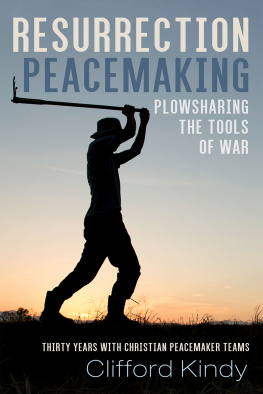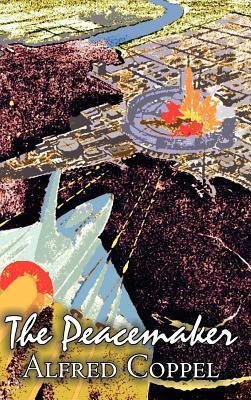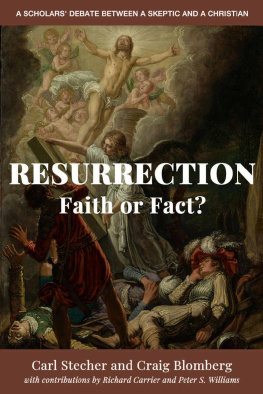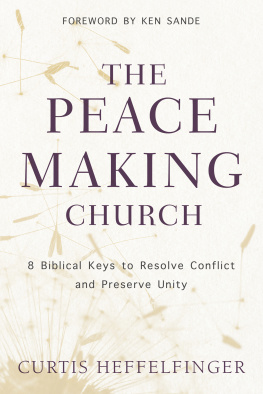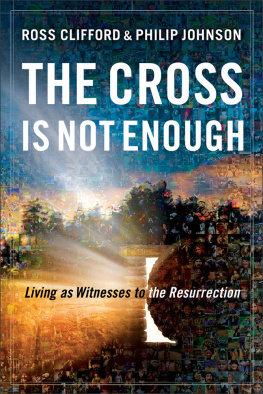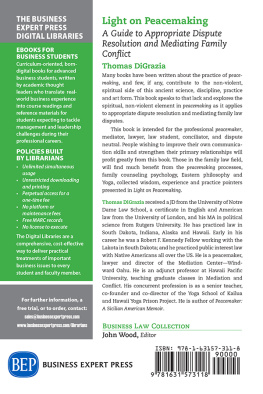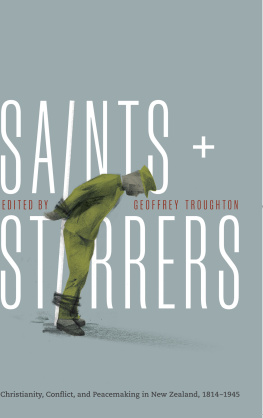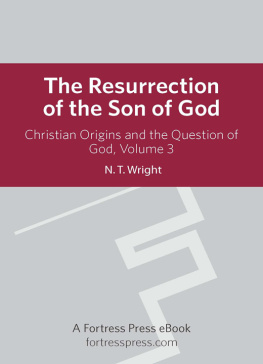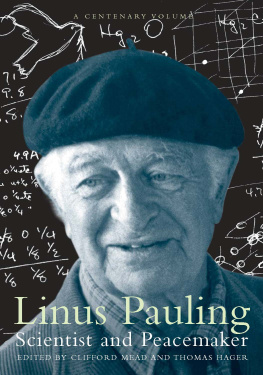Resurrection Peacemaking: Plowsharing the Tools of War
Thirty Years with Christian Peacemaker Teams
Copyright 2020 Clifford Kindy. All rights reserved. Except for brief quotations in critical publications or reviews, no part of this book may be reproduced in any manner without prior written permission from the publisher. Write: Permissions, Wipf and Stock Publishers, W. th Ave., Suite , Eugene, OR 97401 .
The poem in chapter first appeared in The Mennonite, January, 2003 .
Resource Publications
An Imprint of Wipf and Stock Publishers
W. th Ave., Suite
Eugene, OR 97401
www.wipfandstock.com
paperback isbn: 978-1-7252-7896-7
hardcover isbn: 978-1-7252-7897-4
ebook isbn: 978-1-7252-7898-1
Manufactured in the U.S.A. 10/28/20
Table of Contents
Preface
T his book relates stories from my time with Christian Peacemaker Teams (CPT) and connects those stories with the collapse of war. Am I serious that the collapse of war is our new reality? If I draw from my personal experience, it is absolutely true. War has the capacity to destroy everything in its path but is impotent to build up society in any way. Yet war remains the default setting in the political arena, since humanity has not chosen to utilize the available tools of nonviolence.
This is where nonviolence comes into play. Nonviolence is most effective when it intentionally retakes the initiative from the actors of violence. Nonviolence is active, not passive. It has the power to rally civil society because its practice makes sense morally. Nonviolent tools are much more effective than the tools of war. That effectiveness, though, does not mean that nonviolent practitioners will not be injured or killed in the struggle.
My understanding of nonviolence is not some rote textbook application. Nonviolence in a setting of injustice emerges from the wisdom of local partners and the advocacy of a partnering group or groups. At its best, nonviolence flowers from the joint willingness of those colleagues to act with flexibility in the face of risk.
Why will people be willing to risk their lives to confront violence or injustice? For me, that willingness is grounded in the gospel story of Jesus resurrection. For others, it will be based in love and goodness.
Resurrection Peacemaking begins with the drama of Israeli occupation in Gaza. Chapter flies us back to Joyfield Farm in Indiana: what is life like at home for this CPTer? I then discuss the constructive program, an outline that grows a new future. From there we consider where genuine security can be found. Chapter takes us on pilgrimage, a spiritual undergirding for the struggle. The training for a Muslim Peacemaker Team then demonstrates the interfaith nature of nonviolence.
Abruptly, the next two chapters lodge us firmly in Nigeria and the fear and violence of Boko Haram. In Chapter , a poem transfers us back through time to the start of the US invasion of Baghdad in 2003 . Then a glimpse at values of transparency and accountability prepare us to see the Good Samaritan in the guise of our enemy in Chapter .
Great Expectations return us to Iraq to relive that Samaritan gospel story. In Chapter , memories linger from the suicide visitors to our home in Baghdad. Then we glimpse the strong links between corporate capitalism and war, before riding into the wild campo of Colombia in Chapter .
Do violent actors find value in nonviolence? Chapter answers in the affirmative. Then we live with the nonviolent Las Abejas in Chiapas, Mexico, under extreme injustice, before switching to the Chapter campaign against the US Navy in Vieques, Puerto Rico.
Almost as an aside, Chapter takes us on a flying trip into and out of Israel, exposing the calculated violence that over long decades has held Palestinians in a bondage of injustice. Chapter winds our chapters toward a close with an uncompleted campaign to end the manufacture of depleted uranium weapons, followed by an examination of the alternative to either empire violence or radical resistance violence. We reach the summit of the book in the Democratic Republic of the Congo in Chapter , where we meet Pastor Kuye and Sister Maseeka as they retake the initiative from actors of violence.
There are some important appendices. The lead appendix lists some general tools of nonviolence followed by my personal inventory of nonviolent actions, to stimulate readers to shape their own lists. Because war is not the usual mode of living for many of us, Appendix C collects my war blogs from Nigeria depicting the panorama of wars devastation. Appendix D offers brainstorming from the DU campaign to complete the quartet. The book then concludes with a substantial bibliography of further suggested readings for the serious student to consider.
Reader, you are entering a journey. Your world is about to be upended. Hold tightly to your Spirit and be prepared to discover Miracle on your team!
Cliff Kindy, June 2020
Introduction
A collection of guns, with a young man loading the bullets and pulling the triggers, killed fifty people and injured fifty more in Christ c hurch, New Zealand. One wonders if it was fear or self-image that caused the gun manufacturer or the shooter to desire such a result.
Was the manufacturer afraid, or was the young man afraid? Was it fear that caused the operators of the company to sell such a product, to assuage the fear of being poor? Was it the young mans fear that required him to kill people, in this case all of them Muslims? Was he afraid of Muslims? Did killing them end his fear of them or other humans?
Did the killings somehow make him or the gun manufacturer whole? Do human beings need to kill to feel okay in their own bodies? When I need anothers death to somehow complete my wholeness, am I missing something? In war, does killing provide a positive future for me? Does the death of another person, or the ability to manipulate a gun in an effective manner, give me personal psychological affirmation?
When two of us from Christian Peacemaker Teams (CPT) joined the village of Rio Nuevo It in Colombia, the community had just returned from the mountains in which they had taken refuge from violence. Upon return, the first things the community did were to plant bananas, set the hens to hatch eggs, and clean up the ransacked schoolroom for the children. These actions opened a future for them. These planting events provided hope and security for them. These actions plowshared what had been violence and injustice into peace-building events (Isaiah : and Micah :). Using plowshare as a verb highlights the active nature of this transformational process.
It was an armed incursion into their village that had sent the community fleeing into the mountains for refuge. Those same armed actors, military and paramilitary, were still operating in the region. Yet the community of Rio Nuevo It did not feel a need to arm itself to be whole or shield its fear. I suspect the villagers felt some uneasiness, but why did they not feel they needed to obtain guns for safety when the gun manufacturers and young man in New Zealand did?
Alternatively, is it the need to make money that is the driving force in gun manufacture and use? Did the young man somehow gain value by killing people? Do those who encourage war do it for money? Does that justify the action somehow in the minds of politicians? Does our economic system, capitalism, require wars to survive? The push to export weapons for the good of the economy would seem to verify that presumption. What if maximizing wealth or economic power were not our societys objectives?

